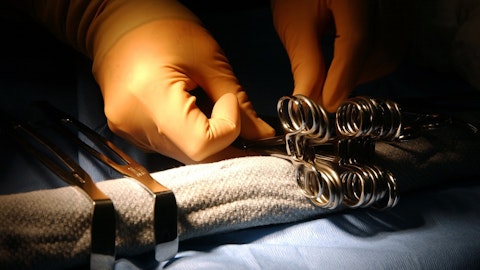Owens & Minor, Inc. (NYSE:OMI) Q4 2023 Earnings Call Transcript February 20, 2024
Owens & Minor, Inc. beats earnings expectations. Reported EPS is $0.69, expectations were $0.68. OMI isn’t one of the 30 most popular stocks among hedge funds at the end of the third quarter (see the details here).
Operator: Good day. And thank you for standing by. Welcome to the Owens & Minor Fourth Quarter 2023 Earnings Conference Call. All lines have been placed on mute to prevent any background noise. After the speakers’ remarks, there will be a question-and-answer session. [Operator Instructions]. Please be advised that today’s conference is being recorded. I would now like to hand the conference over to the first speaker today, Jackie Marcus, Investor Relations. You may begin.
Jackie Marcus: Thank you, operator. Hello, everyone, and welcome to the Owens & Minor fourth quarter 2023 earnings call. Our comments on the call will be focused on the financial results for the fourth quarter of 2023, as well as our updated outlook for 2024, both of which are included in today’s press release. The press release, along with the supplemental slides, are posted on the Investor Relations section of our website. Please note that, during this call, we will make forward-looking statements. The matters addressed in these statements are subject to risks and uncertainties, which could cause actual results to differ materially from those projected or implied here today. Please refer to our SEC filings for a full description of these risks and uncertainties, including the Risk Factors section of our annual report on Form 10-K and quarterly reports on Form 10-Q.
In our discussion today, we will reference certain non-GAAP financial measures and information about these measures and reconciliations to the most comparable GAAP financial measures, which are included in our press release. Today, I’m joined by Ed Pesicka, President and Chief Executive Officer, and Alex Bruni, Executive Vice President and Chief Financial Officer. I will now turn the call over to Ed. Ed?
Edward Pesicka: Thank you, Jackie. Good morning, everyone. And thank you for joining us on the call today. As you saw on our press release this morning, we closed out 2023 with strong positive momentum, and we exited the year in a position of strength. Our Patient Direct segment continued to outpace market growth as we leveraged our proven commercial model in one of the fastest growing areas of health care, the home. Our Products and Healthcare Services segment successfully pivoted as we reset our approach post pandemic. We did this by leveraging the operating model realignment program, executing at a high level and winning new business, which collectively put our P&HS segment on a positive trajectory for revenue growth and margin expansion.
We also finished the year by launching a five-year strategic plan to drive growth and enhanced profitability, and we didn’t wait until 2024 to begin executing on the strategy as we began to invest in both of our segments during the fourth quarter. And finally, we launched our purpose and vision in the fourth quarter, which will continue to solidify a results-oriented culture at Owens & Minor. I’ll provide additional comments on our long term strategy later in my prepared remarks, but now let me focus on 2023. When I reflect on our performance in 2023, I’m extremely proud of how our organization continues to perform against our objectives, and the proof of that hard work and strong execution is evident across our financial results. For example, in fiscal 2023, we generated over $740 million of operating cash flow, which was an annual record for Owens & Minor.
This cash flow performance helped to significantly strengthen our financial profile, as we reduced debt by nearly $600 million during the year. And this strengthened balance sheet will support many of the value creation initiatives included in our five-year strategic plan. Next, during the year, we delivered more than $40 million in operating model realignment benefits, and we exited the year with more than $100 million of run rate. This program helped our product and healthcare services segment deliver meaningful revenue growth and profit improvement in the fourth quarter. Finally, we delivered significant sequential improvement in key performance areas, with adjusted EPS growing from $0.05 in Q1 to $0.69 in Q4 and adjusted operating margin improving from 1.9% in Q1 to 4.2% in Q4.
While revenue declined 8% in Q1, it increased to a positive 4.1% in Q4 on a year-over-year basis. With our Patient Direct segment leading the way with full year 2023 organic revenue growth of nearly 10% and continues to outperform the market while remaining well positioned for further expansion as demand for home-based care accelerates. So, as you can see, we’re excited about our business right now, given the substantial flexibility we’ve established and the strong performance in 2023. Let me close with a quick summary of each segments. In terms of our market leading Patient Direct segment, we had an outstanding year. We grew the business double-digits, continued to expand the overall profit contribution, further the integration of Apria and began investing in additional growth initiatives.
As we look forward, we maintain our belief that we can continue to outpace the market and expand our position as a true leader in home-based care. In terms of our Products and Healthcare Services segment, during 2023, we utilized our operating model realignment program to lower our cost to serve, expand our profits and increase our cash flows, all of which have repositioned the business for long term success. Before I share my thoughts on 2024 and the future for Owens & Minor, I would like to turn the call over to our Chief Financial Officer, Alex Bruni, to discuss our financial performance and our 2024 guidance. Alex?
Alexander Bruni : Thank you, Ed. Good morning, everyone. Diving into our fourth quarter performance. On the top line, we posted a consolidated revenue of $2.7 billion, up more than 4% over the prior year. This uptick in revenue was driven by a nearly 8% year-over-year improvement in our Patient Direct segment, with growth across several product categories. We also saw 3% growth in our Products and Healthcare Services segment compared to the prior year. Notably, there was growth in both the medical distribution and global products divisions in the quarter. For the full year, we reported revenue of $10.3 billion, up 4% year-over-year. Our fourth quarter gross margin was $570 million or 21.5% of revenue compared to $407 million or 16% of revenue in the fourth quarter of 2022.

Full year gross margin was $2.1 billion or 20.6% of revenue, up 221 basis points. Our gross margin improvement can be attributed to the growing contribution from our Patient Direct segment and the efficiency and productivity gains in the Products and Healthcare Services segment. Additionally, the comparison to the prior year was impacted by the non-recurrence of the fourth quarter 2022 inventory valuation adjustment of $92.3 million. Turning to expenses, distribution, selling and administrative expenses for the quarter were $457 million, making up 17.2% of revenue, in line with the fourth quarter of 2022. For the full year, DS&A expenses were $1.8 billion or 17.5% of revenue. The DS&A percentage of revenue reflects the growing contribution from Patient Direct, including a full year of Apria.
GAAP operating income for the quarter was $60 million and adjusted operating income was $111 million. For the full year 2023, GAAP operating income was $105 million and adjusted operating income was $305 million. These results reflect a notable improvement in operating income, increasing by 212% and a 65% growth in adjusted operating income compared to the fourth quarter of 2022. Notably, both the Patient Direct and Products and Healthcare Services segments exhibited sequential increases in segment income from the third to the fourth quarter of 2023. Interest expense for the fourth quarter was $37 million, a 10% decrease from the fourth quarter of last year, largely due to our significant debt reduction during the year. Interest expense for the full year was $158 million, a 23% increase from the prior year, driven primarily by the funding from the Apria acquisition in early 2022.
GAAP net income for the quarter was $0.23 cents per share and adjusted EPS was $0.69. For the full year, GAAP net loss was $0.54 per share and adjusted EPS was $1.36. Adjusted EBITDA in the fourth quarter was $170 million and for the full year was $526 million or 5.1% of revenue. For the operating model realignment program, we delivered in excess of $40 million of adjusted operating income benefit, exceeding our goals of $30 million in the year and exiting the year with an annual run rate of over $100 million. Moving to cash flow and the balance sheet, we continue to generate substantial operating cash flow of $112 million for the quarter and reached a full year total of $741 million, driven by robust working capital management and operating results.
As a result of this significant cash flow, we reduced total debt by $49 million for the fourth quarter and by $403 million for the full year, bringing the balance to $2.1 billion at year-end. In addition, we reduced net debt by $76 million in the fourth quarter and by $577 million for the full year, bringing the balance to $1.9 billion. Net book leverage was 3.5 times at the end of the fourth quarter. Now, let’s look at our full year 2024 guidance. Consistent with what we discussed on the third quarter call and at Investor Day, we expect net revenue to be in the range of $10.5 billion to $10.9 billion, adjusted EBITDA to be in the range of $550 million to $590 million, and adjusted EPS to be in the range of $1.40 to $1.70. Also, as previously discussed, we expect the earnings trajectory to follow our normal seasonal pattern throughout the year.
To help some of you with your models, we’d expect that seasonality to lead to a roughly one-thirds/two-thirds split across the first and second half of the year from an earnings perspective and we’d expect to deliver improvement in each sequential quarter. Looking ahead, we remain committed to delivering the outlook for both segments, having outpaced market growth in our Patient Direct segment and delivered year-over-year profit improvement in Products and Healthcare Services. As we enter 2024, we’re excited to sustain this momentum and to continue on the initial phase of our five year strategy and investment plan, laying the groundwork for continued future success. I’d now like to turn the call back over to Ed for his thoughts on 2024 and Owens & Minor’s role in the future of health care.
Ed?
Edward Pesicka: Thank you, Alex. So, again, we had great execution in 2023 and we remain laser focused on maintaining and accelerating our business momentum as we move forward in 2024. At our Investor Day in December, we shared our Vision 2028 plan, and I outlined three key pillars that are critical to our future growth. These include accelerating growth in the high potential areas of the business, optimizing all of our businesses to drive stronger long term profitability, and leveraging our strong balance sheet by investing across our platforms to drive long term value. In terms of the near term priorities that support these pillars, let’s start with our growth engine, and that’s our Patient Direct segment. We have a proven commercial model across our core categories, including sleep, home respiratory, diabetes, ostomy, urology, and wound care.
These are areas for investment, as we fill geographic gaps, add commercial resources, and invest in technology to improve customer satisfaction, grow revenue, and expand margins. The technology investments will include ecommerce enhancements in our patient management platform and innovative digital marketing. Overall, we will use technology to rethink the patient journey. Lastly, we’ll focus to grow outside of our traditional areas and into adjacencies and other comorbid conditions. The results of these investments, combined with continued strong execution, will enable the Patient Direct segment to continue to grow above market rates. And we believe we can continue to do so by at least 200 basis points per year. Moving to our Products and Healthcare Services segment, we’re going to optimize this business by better leveraging our scale, growing our proprietary product portfolio and expanding into adjacent markets and channels.
As you can see from our results, we are already making progress in delivering on our promises. Andy and his team are investing where the customers find differentiation, and they’re taking costs out where they don’t, ultimately lowering our cost to serve. They are also looking at our footprint to make sure our distribution and manufacturing costs are optimized. While lowering cost to serve remains a priority in P&HS, we are also investing to expand our higher margin proprietary product portfolio, combined with investments to enhance the customer experience. And finally, we’re investing in our business and our teammates for both short and long term. As I mentioned earlier, during 2023, we generated over $740 million of operating free cash flow.
That’s a tremendous number. We’ve also had over $575 million in net debt reduction, another incredible milestone for our company. So with this momentum in mind, we are focused on deploying capital both thoughtfully and timely, with a focus on supporting expansion, technology, and investments in inventory to support new win implementations, enhanced service and portfolio expansion. We’ll also continue to explore additional M&A to expand and scale our business. In conclusion, I’m incredibly excited about the momentum we’re bringing into 2024. And I look forward to sharing our progress with all of you as the year progresses. I’d like to now turn the call over to the operator to open it up for questions. Operator?
See also 10 Best Car Insurance in Massachusetts for 2024 and 13 Largest Refineries in the US.
Q&A Session
Follow Owens & Minor Inc (NYSE:OMI)
Follow Owens & Minor Inc (NYSE:OMI)
Operator: [Operator Instructions]. Your first question comes from the line of Daniel Grosslight from Citi.
Daniel Grosslight: Good to hear that, in P&HS, it’s both products and the distribution that’s growing this quarter. I had a question just around PPE inventory levels at your clients and how that’s shaping up for 2024. Some of the large hospitals have commented that they’re hoping to save money on inventory. Curious how that may impact you. On the third party distributors who are buying your PPE, any more clarity on how their inventory levels are shaping up?
Edward Pesicka: I think the first factor is, and you alluded to that and you said that upfront is, we actually saw growth in both parts of the business this quarter, both Products and Healthcare Services as well as Patient Direct. And if think about the divisions within Products and Healthcare Services, we have seen – I don’t want to say the bottom, but we’re starting to see – we’ve seen it level out within our products business specifically. While the demand has been consistent, we’re now starting to see that slightly uptick. We do still have some customers that have some additional stock, and we’re helping them burn through that. Now, we’ve also done a nice job beginning to burn through some of our excess inventory during 2023.
So, as we look into 2024, we expect that the start to ramp in the upward direction and provide some momentum. So, that’s how we’re thinking about the PPE specifically. There’s some categories where we’re seeing faster growth than other. I think surgical is a great example of that, and we’re starting to see demand for PPE escalate as people have burned through those products and we’re seeing the surgery rate starting to slightly increase. So that’s how we’re seeing it from a qualitative standpoint.
Daniel Grosslight: You kind of alluded to this as well at the end here. But one of the key initiatives of the model realignment plan is rethinking your manufacturing footprint, including potentially producing more products overseas. I’m curious if the current conflict in the Red Sea has changed how you’re thinking about your manufacturing footprint, potentially keeping more sites in North and South and Central America, or anything has changed?
Edward Pesicka: Just sort of high level, one, we really haven’t – let me step back. When we think about where our manufacturing footprint should be, we don’t think it should be in one specific geographic location. We take all the different circumstances and all the different issues that potentially can run as we look at it. And if you look at our footprint today, it’s primarily in the Americas, both North America, Central America, with the one exception is our gloves, which are in Thailand. If we think about where our shipping channels are today, it really is not impacted by those issues that are in the market today because we’re shipping really directly to the West Coast. And if we do, we go through the Panama Canal, if we have to get to the East Coast.
And we look at our shipping partners on the Panama Canal, we have preset slots that enable us to get through. And we’ve seen about a one to three day delay at most within that, but generally speaking we have our time slots, we have it lined up, and it hasn’t impacted us. As we think about the manufacturing footprint more broadly going forward, we’ll continue to look at where does it create opportunities for us to get the products that we need at the right price that the customers demand and be able to service them? So, I guess, overall, the current situation in Suez Canal is not impacting us because it’s not a primary shipping channel for us. If we think about where we are today, if we have to use one of those canals, we use Panama Canal where we ship to the West Coast.
And based on our footprint, it’s a different footprint we have today. And as we go into the future, we’ll take those things into consideration as we continue to remap out our manufacturing footprint.
Operator: Your next question comes from the line of Kevin Caliendo from UBS.
Kevin Caliendo: I want to go through the EBITDA guidance for 2024 and just sort of understand what some of the assumptions are in there. First, how much is embedded for the cost savings realignment. You mentioned there was a run rate of $100 million exiting 2023? How much of that is sort of captured in the $550 million to $590 million? And also, can you talk about the net headwinds? Or is there a net headwind from the DME POS benefit versus the 75/25 rule?
Edward Pesicka: Maybe I can start and then Alex can add some color. So let me just talk a little bit about just the operating model realignment and the carry forward, and the bulk of that is going to end up in actually our profits or earnings before the interest, really the earnings part of EBITDA. And one of the things I think we’ve tried to clearly state both at Investor Day as well as on some of our prepared remarks was the fact that the savings that we’ve gained from that, in addition to the run rate we have, the vast majority of that is going to be reinvested back into the business. And we’re pretty comfortable in the range where we are from both EBITDA as well as EPS for 2024. And if I think about some of that, I think it’s important understand where are the big buckets we’re going to be investing in that, and I’ll talk about it in the two segments.




